This document provides an overview of European and American art from 1715-1840. It discusses three major artistic styles that flourished during this period: Rococo, Neoclassicism, and Romanticism. For Rococo, it describes the ornate salon decor and paintings of Watteau, Boucher, and Fragonard that featured mythological themes. Neoclassicism grew from the Grand Tour to Italy and featured portraits, cityscapes, and sculptures that drew inspiration from classical antiquity such as the works of Mengs and Canova. British Neoclassicism combined patriotism and civic virtue while Romanticism embraced emotion. Architecture during this period turned to classical Greek and Roman designs for inspiration,



![John Singleton Copley THOMAS MIFFLIN AND SARAH MORRIS (MR. AND MRS.
MIFFLIN)
1773. Oil on canvas, 61-5/8" × 48" (156.5 × 121.9 cm).
Philadelphia Museum of Art. © 2016. Photo Art Resource/Scala, Florence. [Fig. 30-01]](https://image.slidesharecdn.com/0134484592ch30-190210221811/85/0134484592-ch30-4-320.jpg)



![EUROPE AND NORTH AMERICA IN THE EIGHTEENTH CENTURY
During the eighteenth century, three major artistic styles—Rococo, Neoclassicism, and
Romanticism—flourished in Europe and North America. [Map 30-01]](https://image.slidesharecdn.com/0134484592ch30-190210221811/85/0134484592-ch30-8-320.jpg)


![Germain Boffrand SALON DE LA PRINCESSE, HÔTEL DE SOUBISE
Paris. Begun 1732.
© Hervé Champollion/akg-images. [Fig. 30-02]](https://image.slidesharecdn.com/0134484592ch30-190210221811/85/0134484592-ch30-11-320.jpg)


![Jean-Antoine Watteau THE SIGNBOARD OF GERSAINT
c. 1721. Oil on canvas, 5'4" × 10'1" (1.62 × 3.06 m).
Stiftung Preussische Schlössen und Gärten Berlin-Brandenburg, Schloss Charlottenburg.
© akg-images/Erich Lessing. [Fig. 30-03]](https://image.slidesharecdn.com/0134484592ch30-190210221811/85/0134484592-ch30-14-320.jpg)
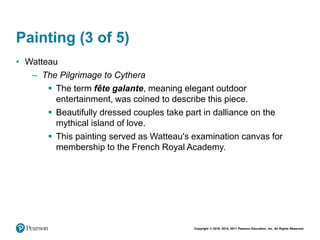
![Jean-Antoine Watteau PILGRIMAGE TO THE ISLAND OF CYTHERA
1717. Oil on canvas, 4'3" × 6'4-1/2" (1.3 × 1.9 m).
Musée du Louvre, Paris. Photo © RMN-Grand Palais (musée du Louvre)/Stéphane
Maréchalle. [Fig. 30-04]](https://image.slidesharecdn.com/0134484592ch30-190210221811/85/0134484592-ch30-16-320.jpg)

![François Boucher GIRL RECLINING: LOUISE O'MURPHY
1751. Oil on canvas, 23-1/4" × 28-3/4" (59 × 73 cm).
Wallraf-Richartz Museum, Cologne. Rheinisches Bildarchiv, Museen der Stadt Köln.
[Fig. 30-05]](https://image.slidesharecdn.com/0134484592ch30-190210221811/85/0134484592-ch30-18-320.jpg)

![Jean-Honoré Fragonard THE SWING
1767. Oil on canvas, 31-7/8 × 25-1/4" (81 × 64.2 cm).
The Wallace Collection, London. © Wallace Collection, London, UK/Bridgeman Images.
[Fig. 30-06]](https://image.slidesharecdn.com/0134484592ch30-190210221811/85/0134484592-ch30-20-320.jpg)

![Clodion THE INVENTION OF THE BALLOON
1784. Terra-cotta model for a monument, height 43-1/2" (110.5 cm).
Metropolitan Museum of Art, New York. Rogers Fund and Frederick R. Harris Gift, 1944
(44.21a b). © 2016. Image copyright The Metropolitan Museum of Art/Art Resource, NY.
[Fig. 30-07]](https://image.slidesharecdn.com/0134484592ch30-190210221811/85/0134484592-ch30-22-320.jpg)

![PLAN OF THE CHURCH OF THE VIERZEHNHEILIGEN
Near Bamberg, Bavaria, Germany. c. 1743. [Fig. 30-08]](https://image.slidesharecdn.com/0134484592ch30-190210221811/85/0134484592-ch30-24-320.jpg)

![Johann Balthasar Neumann INTERIOR, CHURCH OF THE VIERZEHNHEILIGEN
Near Bamberg, Bavaria, Germany. 1743–1772.
© Achim Bednorz, Cologne. [Fig. 30-09]](https://image.slidesharecdn.com/0134484592ch30-190210221811/85/0134484592-ch30-26-320.jpg)



![Rosalba Carriera GUSTAVUS HAMILTON, 2ND VISCOUNT BOYNE
1730–1731. Pastel on blue paper, 221⁄4 × 16-7⁄8″ (56.5 × 42.9 cm). Metropolitan
Museum, New York. © 2016. Image copyright The Metropolitan Museum of Art/Art
Resource/Scala, Florence. [Fig. 30-10]](https://image.slidesharecdn.com/0134484592ch30-190210221811/85/0134484592-ch30-30-320.jpg)

![Canaletto THE DOGE'S PALACE AND THE RIVA DEGLI SCHIAVONI
Late 1730s. Oil on canvas, 24-1/8" × 39-1/4" (61.3 × 99.8 cm).
National Gallery, London. Wynn Ellis Bequest 1876 (NG 940). © 2016. Copyright The
National Gallery, London/Scala, Florence. [Fig. 30-11]](https://image.slidesharecdn.com/0134484592ch30-190210221811/85/0134484592-ch30-32-320.jpg)

![Giovanni Battista Piranesi VIEW OF THE PANTHEON, ROME
From the Views of Rome series, first printed in 1756.
Etching, 18-9/16" × 27-1/8" (47.2 × 69.7 cm).
Yale University Art Gallery, the Arthur Rose Collection. (2012.159.11.60). Image courtesy
Yale University Art Gallery. [Fig. 30-12]](https://image.slidesharecdn.com/0134484592ch30-190210221811/85/0134484592-ch30-34-320.jpg)


![Anton Raphael Mengs PARNASSUS
Ceiling fresco in the Villa Albani, Rome. 1761.
© akg-images/Mondadori Portfolio/Sergio Anelli. [Fig. 30-13]](https://image.slidesharecdn.com/0134484592ch30-190210221811/85/0134484592-ch30-37-320.jpg)

![Antonio Canova CUPID AND PSYCHE
1787–1793. Marble, 61 × 68" (1.55 × 1.73 m).
Musée du Louvre, Paris. Photo © Dist. RMN-Grand Palais/Raphaël Chipault. [Fig. 30-14]](https://image.slidesharecdn.com/0134484592ch30-190210221811/85/0134484592-ch30-39-320.jpg)

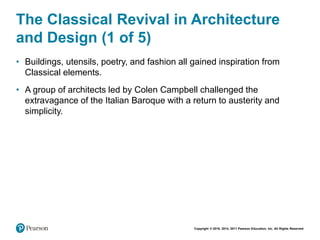

![Richard Boyle (Lord Burlington) EXTERIOR VIEW OF CHISWICK HOUSE
West London, England. 1724–1729. Interior decoration (1726–1729) and new gardens
(1730–1740) by William Kent. © Achim Bednorz, Cologne. [Fig. 30-15a]](https://image.slidesharecdn.com/0134484592ch30-190210221811/85/0134484592-ch30-43-320.jpg)
![Richard Boyle (Lord Burlington) PLAN OF CHISWICK HOUSE
West London, England. 1724.
[Fig. 30-15b]](https://image.slidesharecdn.com/0134484592ch30-190210221811/85/0134484592-ch30-44-320.jpg)

![Henry Flitcroft and Henry Hoare THE PARK AT STOURHEAD
Wiltshire, England.
Laid out 1743, executed 1744–1765, with continuing additions.
Gail Johnson/Fotolia. [Fig. 30-16]](https://image.slidesharecdn.com/0134484592ch30-190210221811/85/0134484592-ch30-46-320.jpg)
![A CLOSER LOOK: Georgian Silver
Elizabeth Morley: George III toddy ladle, 1802; Alice and George Burrows: George III
snuffbox, 1802; Elizabeth Cooke: George III salver, 1767; Ann and Peter Bateman:
George III goblet, 1797; Hester Bateman: George III double beaker, 1790. National
Museum of Women in the Arts, Washington, DC. Silver collection assembled by Nancy
Valentine. Purchased with funds donated by Mr. and Mrs. Oliver Grace and family.
[Fig. 30-17]](https://image.slidesharecdn.com/0134484592ch30-190210221811/85/0134484592-ch30-47-320.jpg)

![Josiah Wedgwood THE APOTHEOSIS OF HOMER
Made at the Wedgwood Etruria factory, Staffordshire, England. 1790–1795.
White jasperware body with a mid-blue dip and white relief, height 18" (45.7 cm).
Relief of The Apotheosis of Homer adapted from a plaque by John Flaxman, Jr., 1778.
Trustees of the Wedgwood Museum, Barlaston, Staffordshire, England. Photo ©
Wedgwood Museum/WWRD. [Fig. 30-18]](https://image.slidesharecdn.com/0134484592ch30-190210221811/85/0134484592-ch30-49-320.jpg)

![William Hackwood for Josiah Wedgwood "AM I NOT A MAN AND A BROTHER?"
1787. Black-and-white jasperware, 1-3/8" × 1-3/8" (3.5 × 3.5 cm).
Trustees of the Wedgwood Museum, Barlaston, Staffordshire, England. Photo ©
Wedgwood Museum/WWRD. [Fig. 30-19]](https://image.slidesharecdn.com/0134484592ch30-190210221811/85/0134484592-ch30-51-320.jpg)

![Horace Walpole and others STRAWBERRY HILL
Twickenham, England. 1749–1776.
Photo: Robert Neuman. [Fig. 30-20]](https://image.slidesharecdn.com/0134484592ch30-190210221811/85/0134484592-ch30-53-320.jpg)
![Horace Walpole, John Chute, and Richard Bentley PICTURE GALLERY SHOWING
FAN-VAULTED CEILING, STRAWBERRY HILL
After 1754.
© akg-images /A.F.Kersting. [Fig. 30-21]](https://image.slidesharecdn.com/0134484592ch30-190210221811/85/0134484592-ch30-54-320.jpg)

![Abraham Darby III SEVERN RIVER BRIDGE
Coalbrookdale, England. 1779.
© Dorling Kindersley. [Fig. 30-22]](https://image.slidesharecdn.com/0134484592ch30-190210221811/85/0134484592-ch30-56-320.jpg)


![William Hogarth THE MARRIAGE CONTRACT
From Marriage à la Mode, 1743–1745.
Oil on canvas, 27-1/2" × 35-3/4" (69.9 × 90.8 cm).
National Gallery, London. © 2016. Copyright The National Gallery, London/Scala,
Florence. [Fig. 30-23]](https://image.slidesharecdn.com/0134484592ch30-190210221811/85/0134484592-ch30-59-320.jpg)


![Joshua Reynolds LADY SARAH BUNBURY SACRIFICING TO THE GRACES
1765. Oil on canvas, 7'10" × 5' (2.42 × 1.53 m).
The Art Institute of Chicago. Mr. and Mrs. W. W. Kimball Collection, 1922.4468.
© akg-images/De Agostini Picture Lib. [Fig. 30-24]](https://image.slidesharecdn.com/0134484592ch30-190210221811/85/0134484592-ch30-62-320.jpg)

![Thomas Gainsborough ROBERT ANDREWS AND FRANCES CARTER
(MR. AND MRS. ANDREWS)
c. 1748–1750. Oil on canvas, 27-1/2" × 47" (69.7 × 119.3 cm).
National Gallery, London. © 2016. Copyright The National Gallery, London/Scala,
Florence. [Fig. 30-25]](https://image.slidesharecdn.com/0134484592ch30-190210221811/85/0134484592-ch30-64-320.jpg)

![Joseph Wright of Derby AN EXPERIMENT ON A BIRD IN THE AIR-PUMP
1768. Oil on canvas, 6' × 8' (1.82 × 2.43 m).
National Gallery, London. © 2016. Copyright The National Gallery, London/Scala,
Florence. [Fig. 30-26]](https://image.slidesharecdn.com/0134484592ch30-190210221811/85/0134484592-ch30-66-320.jpg)

![Johann Zoffany ACADEMICIANS OF THE ROYAL ACADEMY
1771–1772. Oil on canvas, 47-1/2" × 59-1/2" (120.6 × 151.2 cm).
The Royal Collection, Windsor Castle, England. Royal Collection Trust © Her Majesty
Queen Elizabeth II, 2016/. Bridgeman Images. [Fig. 30-27]](https://image.slidesharecdn.com/0134484592ch30-190210221811/85/0134484592-ch30-68-320.jpg)

![Angelica Kauffmann CORNELIA POINTING TO HER CHILDREN AS HER TREASURES
c. 1785. Oil on canvas, 40 × 50" (101.6 × 127 cm).
Virginia Museum of Fine Arts, Richmond, Virginia. The Adolph D. and Wilkins C. Williams
Fund. Virginia Museum of Fine Arts, Richmond. Photo: Katherine Wetzel. [Fig. 30-28]](https://image.slidesharecdn.com/0134484592ch30-190210221811/85/0134484592-ch30-70-320.jpg)

![Benjamin West THE DEATH OF GENERAL WOLFE
1770. Oil on canvas, 4'11-1/2" × 7' (1.51 × 2.14 m).
National Gallery of Canada, Ottawa. Transfer from the Canadian War Memorials, 1921.
Gift of the 2nd Duke of Westminster, Eaton Hall, Cheshire, 1918. National Gallery of
Canada, Ottawa. [Fig. 30-29]](https://image.slidesharecdn.com/0134484592ch30-190210221811/85/0134484592-ch30-72-320.jpg)

![John Henry Fuseli THE NIGHTMARE
1781. Oil on canvas, 39-3/4" × 49-1/2" (101 × 127 cm).
The Detroit Institute of Arts. Founders Society purchase with Mr. and Mrs. Bert L.
Smokler and Mr. and Mrs. Lawrence A. Fleischmann funds. Bridgeman Images.
[Fig. 30-30]](https://image.slidesharecdn.com/0134484592ch30-190210221811/85/0134484592-ch30-74-320.jpg)

![William Blake NEWTON
1795–c. 1805.
Color print finished in ink and watercolor, 18-1/8" × 23-5/8" (46 × 60 cm).
Tate, London. Photo © Peter Willi/ARTOTHEK. [Fig. 30-31]](https://image.slidesharecdn.com/0134484592ch30-190210221811/85/0134484592-ch30-76-320.jpg)

![John Singleton Copley WATSON AND THE SHARK
1778. Oil on canvas, 5'10-3/4" × 7'6-1/2" (1.82 × 2.29 m).
National Gallery of Art, Washington, DC. Ferdinand Lammot Belin Fund. Image courtesy
the National Gallery of Art, Washington. [Fig. 30-32]](https://image.slidesharecdn.com/0134484592ch30-190210221811/85/0134484592-ch30-78-320.jpg)
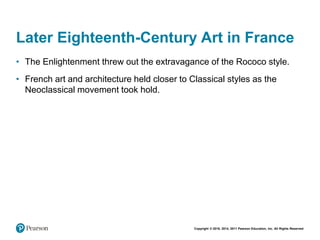

![Jacques-Germain Soufflot PANTHÉON (CHURCH OF SAINTE-GENEVIÉVE), PARIS
1755–1792.
JonRob/Fotolia. [Fig. 30-33]](https://image.slidesharecdn.com/0134484592ch30-190210221811/85/0134484592-ch30-81-320.jpg)
![CUTAWAY ILLUSTRATION OF THE PANTHÉON
© Dorling Kindersley. [Fig. 30-34]](https://image.slidesharecdn.com/0134484592ch30-190210221811/85/0134484592-ch30-82-320.jpg)


![Jean-Siméon Chardin SAYING GRACE
c. 1740. Oil on canvas, 19 × 15-1⁄8″ (49 × 38 cm).
Musée du Louvre, Paris. Photo © Musée du Louvre, Dist. RMN-Grand Palais/Angèle
Dequier. [Fig. 30-35]](https://image.slidesharecdn.com/0134484592ch30-190210221811/85/0134484592-ch30-85-320.jpg)

![Jean-Baptiste Greuze THE VILLAGE BRIDE, OR THE MARRIAGE, THE MOMENT
WHEN A FATHER GIVES HIS SON-IN-LAW A DOWRY
1761. Oil on canvas, 36" × 46 1/2" (91.4 × 118.1 cm).
Musée du Louvre, Paris. Photo © RMN-Grand Palais (musée du Louvre)/Franck Raux.
[Fig. 30-36]](https://image.slidesharecdn.com/0134484592ch30-190210221811/85/0134484592-ch30-87-320.jpg)

![Marie-Louise-Élisabeth Vigée-Lebrun PORTRAIT OF MARIE ANTOINETTE WITH HER
CHILDREN
1787. Oil on canvas, 9'-1/2" × 7'-5/8" (2.75 × 2.15 m).
Musée National du Château de Versailles. © Jean Feuillie/Centre des monuments
nationaux. [Fig. 30-37]](https://image.slidesharecdn.com/0134484592ch30-190210221811/85/0134484592-ch30-89-320.jpg)

![Jacques-Louis David OATH OF THE HORATII
1784–1785. Oil on canvas, 10'8-1/4" × 14' (3.26 × 4.27 m).
Musée du Louvre, Paris. Photo © RMN-Grand Palais (musée du Louvre)/ Gérard
Blot/Christian Jean. [Fig. 30-38]](https://image.slidesharecdn.com/0134484592ch30-190210221811/85/0134484592-ch30-91-320.jpg)

![Jacques-Louis David DEATH OF MARAT
1793. Oil on canvas, 5'5" × 4'2-1/2" (1.65 × 1.28 m).
© Royal Museums of Fine Arts of Belgium, Brussels. © Royal Museums of Fine Arts of
Belgium, Brussels/Photo: J. Geleyns - Roscan. [Fig. 30-39]](https://image.slidesharecdn.com/0134484592ch30-190210221811/85/0134484592-ch30-93-320.jpg)

![Anne-Louis Girodet-Trioson PORTRAIT OF JEAN-BAPTISTE BELLEY
1797. Oil on canvas, 5'2-1/2" × 3'8-1/2" (1.59 × 1.13 m).
Musée National du Château de Versailles. Photo © RMN-Grand Palais (Château de
Versailles)/Gérard Blot. [Fig. 30-40]](https://image.slidesharecdn.com/0134484592ch30-190210221811/85/0134484592-ch30-95-320.jpg)

![Adélaïde Labille-Guiard SELF-PORTRAIT WITH TWO PUPILS
1785. Oil on canvas, 6'11" × 4'11-1/2" (2.11 × 1.51 m).
Metropolitan Museum of Art, New York. Gift of Julia A. Berwind, 1953 (53.225.5).
© 2016. Image copyright The Metropolitan Museum of Art/Art Resource/Scala, Florence.
[Fig. 30-41]](https://image.slidesharecdn.com/0134484592ch30-190210221811/85/0134484592-ch30-97-320.jpg)
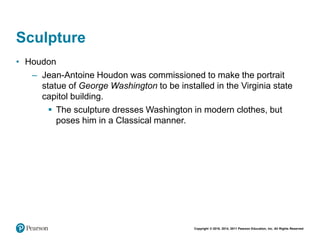
![Jean-Antoine Houdon GEORGE WASHINGTON
1788–1792. Marble, height 6'2" (1.9 m).
State Capitol, Richmond, Virginia. [Fig. 30-42]](https://image.slidesharecdn.com/0134484592ch30-190210221811/85/0134484592-ch30-99-320.jpg)
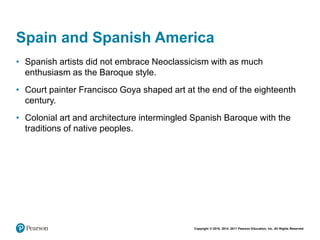

![Francisco Goya THE SLEEP OF REASON PRODUCES MONSTERS
No. 43 from Los Caprichos (The Caprices). 1796–1798; published 1799. Etching and
aquatint, 8-1/2" × 6" (21.6 × 15.2 cm). Yale University Art Gallery. Bequest of Ralph
Kirkpatrick, Hon. M.A. 1965 (1984.54.92.43). Image courtesy Yale University Art Gallery.
[Fig. 30-43]](https://image.slidesharecdn.com/0134484592ch30-190210221811/85/0134484592-ch30-102-320.jpg)
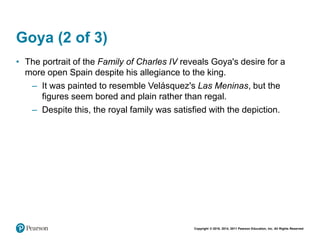
![Francisco Goya FAMILY OF CHARLES IV
1800. Oil on canvas, 9'2" × 11' (2.79 × 3.36 m).
Museo del Prado, Madrid. © 2016. Image copyright Museo Nacional del Prado. © Photo
MNP/Photo Scala, Florence. [Fig. 30-44]](https://image.slidesharecdn.com/0134484592ch30-190210221811/85/0134484592-ch30-104-320.jpg)

![Francisco Goya THIRD OF MAY, 1808
1814–1815. Oil on canvas, 8'9" × 13'4" (2.67 × 4.06 m).
Museo del Prado, Madrid. © 2016. Image copyright Museo Nacional del Prado. © Photo
MNP/Scala, Florence. [Fig. 30-45]](https://image.slidesharecdn.com/0134484592ch30-190210221811/85/0134484592-ch30-106-320.jpg)

![ATRIAL CROSS
Before 1556. Stone, height 11'3" (3.45 m).
Chapel of the Indians, Basilica of Guadalupe, Mexico City. © Jamie Lara. [Fig. 30-46]](https://image.slidesharecdn.com/0134484592ch30-190210221811/85/0134484592-ch30-108-320.jpg)

![Sebastian Salcedo VIRGIN OF GUADALUPE
1779. Oil on panel and copper, 25" × 19" (63.5 × 48.3 cm).
Denver Art Museum. Funds contributed by Mr. and Mrs. George G. Anderman and an
anonymous donor (1976.56). [Fig. 30-47]](https://image.slidesharecdn.com/0134484592ch30-190210221811/85/0134484592-ch30-110-320.jpg)

![MISSION SAN XAVIER DEL BAC
Near Tucson, Arizona. 1784–1797.
Paul Moore/Fotolia. [Fig. 30-48]](https://image.slidesharecdn.com/0134484592ch30-190210221811/85/0134484592-ch30-112-320.jpg)



![Jacques-Louis David NAPOLEON CROSSING THE SAINT-BERNARD
1800–1801. Oil on canvas, 8'11" × 7'7" (2.7 × 2.3 m).
Versailles, Châteaux de Versailles et de Trianon. Photo © RMN-Grand Palais (Château
de Versailles)/Franck Raux. [Fig. 30-49]](https://image.slidesharecdn.com/0134484592ch30-190210221811/85/0134484592-ch30-116-320.jpg)

![Antoine-Jean Gros NAPOLEON IN THE PLAGUE HOUSE AT JAFFA
1804. Oil on canvas, 17'5" × 23'7" (5.32 × 7.2 m).
Musée du Louvre, Paris. Photo © RMN-Grand Palais (musée du Louvre)/Thierry Le
Mage. [Fig. 30-50]](https://image.slidesharecdn.com/0134484592ch30-190210221811/85/0134484592-ch30-118-320.jpg)


![Théodore Géricault THE RAFT OF THE MEDUSA
1818–1819. Oil on canvas, 16'1" × 23'6" (4.9 × 7.16 m).
Musée du Louvre, Paris. © akg-images/Erich Lessing. [Fig. 30-51]](https://image.slidesharecdn.com/0134484592ch30-190210221811/85/0134484592-ch30-121-320.jpg)
![Théodore Géricault THE SIGHTING OF THE ARGUS
1818. Pen and ink on paper, 13-3/4" × 16-1/8" (34.9 × 41 cm).
Musée des Beaux-Arts, Lille. Photo © RMN-Grand Palais/Philipp Bernard. [Fig. 30-52]](https://image.slidesharecdn.com/0134484592ch30-190210221811/85/0134484592-ch30-122-320.jpg)
![Théodore Géricault THE SIGHTING OF THE "ARGUS"
1818. Pen and ink, sepia wash on paper, 8-1/8" × 11-1/4" (20.6 × 28.6 cm).
Musée des Beaux-Arts, Rouen. Photo © RMN-Grand Palais/Philipp Bernard. [Fig. 30-53]](https://image.slidesharecdn.com/0134484592ch30-190210221811/85/0134484592-ch30-123-320.jpg)
![Théodore Géricault STUDY OF HANDS AND FEET
1818–1819. Oil on canvas, 20-1/2" × 25-3/18" (52 × 64 cm).
Musée Fabre de Montpellier. Musée Fabre de Montpellier Agglomération.
Photo: Frédéric Jaulmes.[Fig. 30-54]](https://image.slidesharecdn.com/0134484592ch30-190210221811/85/0134484592-ch30-124-320.jpg)

![Eugène Delacroix LIBERTY LEADING THE PEOPLE: JULY 28, 1830
1830. Oil on canvas, 8'6-1/2" × 10'8" (2.6 × 3.25 m).
Musée du Louvre, Paris. Photo © Musée du Louvre, Dist. RMN-Grand Palais/Philippe
Fuzeau. [Fig. 30-55]](https://image.slidesharecdn.com/0134484592ch30-190210221811/85/0134484592-ch30-126-320.jpg)
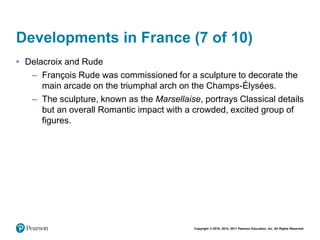
![François Rude DEPARTURE OF THE VOLUNTEERS OF 1792 (THE MARSEILLAISE)
Arc de Triomphe, Place de l'Étoile, Paris. 1833–1836.
Limestone, height approx. 42' (12.8 m).
© Kiev.Victor/Shutterstock. [Fig. 30-56]](https://image.slidesharecdn.com/0134484592ch30-190210221811/85/0134484592-ch30-128-320.jpg)

![Jean-Auguste-Dominique Ingres LARGE ODALISQUE
1814. Oil on canvas, approx. 35" × 64" (88.9 × 162.5 cm).
Musée du Louvre, Paris. Photo © RMN-Grand Palais (musée du Louvre)/Thierry Le
Mage. [Fig. 30-57]](https://image.slidesharecdn.com/0134484592ch30-190210221811/85/0134484592-ch30-130-320.jpg)

![Jean-Auguste-Dominique Ingres PORTRAIT OF MADAME DÉSIRÉ RAOUL-ROCHETTE
1830. Graphite on paper, 12-5/8" × 9-1/2" (32.2 × 24.1 cm).
Cleveland Museum of Art. Purchase from the J. H. Wade Fund (1927.437).
Bridgeman Images. [Fig. 30-58]](https://image.slidesharecdn.com/0134484592ch30-190210221811/85/0134484592-ch30-132-320.jpg)

![Honoré Daumier THE PRINT LOVERS
c. 1863–1865. Watercolor, black pencil, black ink, gray wash, 10-1/8" × 12-1/8" (25.8 ×
30.7 cm). Musée du Louvre, Paris. Photo © RMN-Grand Palais (musée du Louvre).
[Fig. 30-59]](https://image.slidesharecdn.com/0134484592ch30-190210221811/85/0134484592-ch30-134-320.jpg)


![Honoré Daumier RUE TRANSNONAIN, LE 15 AVRIL 1834
1834. Lithograph, 11" × 17-3/8" (28 × 44 cm).
Yale University Art Gallery, Everett V. Meeks, B.A. 1901, Fund (1982.120.4).
Image courtesy Yale University Art Gallery. [Fig. 30-60]](https://image.slidesharecdn.com/0134484592ch30-190210221811/85/0134484592-ch30-137-320.jpg)


![John Constable THE HAY WAIN
1821. Oil on canvas, 51-1/4" × 73" (130.2 × 185.4 cm).
National Gallery, London. Gift of Henry Vaughan, 1886.
© 2016. Copyright The National Gallery, London/Scala, Florence. [Fig. 30-61]](https://image.slidesharecdn.com/0134484592ch30-190210221811/85/0134484592-ch30-140-320.jpg)
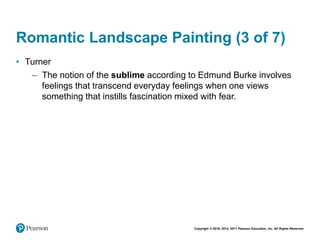

![Joseph Mallord William Turner SNOWSTORM: HANNIBAL AND HIS ARMY
CROSSING THE ALPS
1812. Oil on canvas, 4'9" × 7'9" (1.46 × 2.39 m).
Tate, London. © akg-images/De Agostini Picture Library. [Fig. 30-62]](https://image.slidesharecdn.com/0134484592ch30-190210221811/85/0134484592-ch30-143-320.jpg)

![Joseph Mallord William Turner THE BURNING OF THE HOUSES OF LORDS AND
COMMONS, 16TH OCTOBER 1834
Oil on canvas, 36-1/4" × 48-1/2" (92.1 × 123.2 cm).
Philadelphia Museum of Art. The John Howard McFadden Collection, 1928. © 2016.
Photo The Philadelphia Museum of Art/Art Resource/Scala, Florence. [Fig. 30-63]](https://image.slidesharecdn.com/0134484592ch30-190210221811/85/0134484592-ch30-145-320.jpg)

![Thomas Cole THE OXBOW
1836. Oil on canvas, 51-1/2" × 76" (1.31 × 1.94 m).
Metropolitan Museum of Art, New York. Gift of Mrs. Russell Sage, 1908 (08.228).
© 2016. Image copyright The Metropolitan Museum of Art/Art Resource/Scala, Florence.
[Fig. 30-64]](https://image.slidesharecdn.com/0134484592ch30-190210221811/85/0134484592-ch30-147-320.jpg)

![Caspar David Friedrich ABBEY IN AN OAK FOREST
1809–1810. Oil on canvas, 44" × 68-1/2" (111.8 × 174 cm).
Nationalgalerie, Berlin. © Photo Scala, Florence/bpk, Bildagentur für Kunst, Kultur und
Geschichte, Berlin. Photo: Joerg P. Anders. [Fig. 30-65]](https://image.slidesharecdn.com/0134484592ch30-190210221811/85/0134484592-ch30-149-320.jpg)


![Charles Barry and Augustus Welby Northmore Pugin HOUSES OF PARLIAMENT,
LONDON
1836–1860. Royal Commission on the Historical Monuments of England, London.
© S.Borisov/Shutterstock. [Fig. 30-66]](https://image.slidesharecdn.com/0134484592ch30-190210221811/85/0134484592-ch30-152-320.jpg)

![Richard Upjohn TRINITY CHURCH, NEW YORK CITY
1839–1846.
Leo Sorel Photography. [Fig. 30-67]](https://image.slidesharecdn.com/0134484592ch30-190210221811/85/0134484592-ch30-154-320.jpg)

![Karl Friedrich Schinkel ALTES MUSEUM, BERLIN
1822–1830.
© 2016. Photo Scala, Florence/bpk, Bildagentur für Kunst, Kultur und Geschichte, Berlin.
Photo: Volker-H Schneider. [Fig. 30-68]](https://image.slidesharecdn.com/0134484592ch30-190210221811/85/0134484592-ch30-156-320.jpg)

![Benjamin Henry Latrobe U.S. CAPITOL, WASHINGTON, DC
c. 1808. Engraving by T. Sutherland, 1825.
Library of Congress, Prints and Photographs Division,Washington D.C.
Courtesy the Library of Congress. [Fig. 30-69]](https://image.slidesharecdn.com/0134484592ch30-190210221811/85/0134484592-ch30-158-320.jpg)
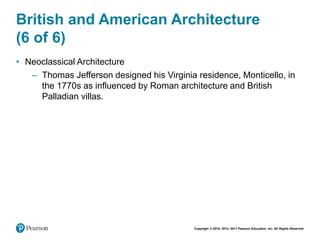
![Thomas Jefferson MONTICELLO
Charlottesville, Virginia. 1769–1782, 1796–1809.
© Ffooter/Shutterstock. [Fig. 30-70]](https://image.slidesharecdn.com/0134484592ch30-190210221811/85/0134484592-ch30-160-320.jpg)

